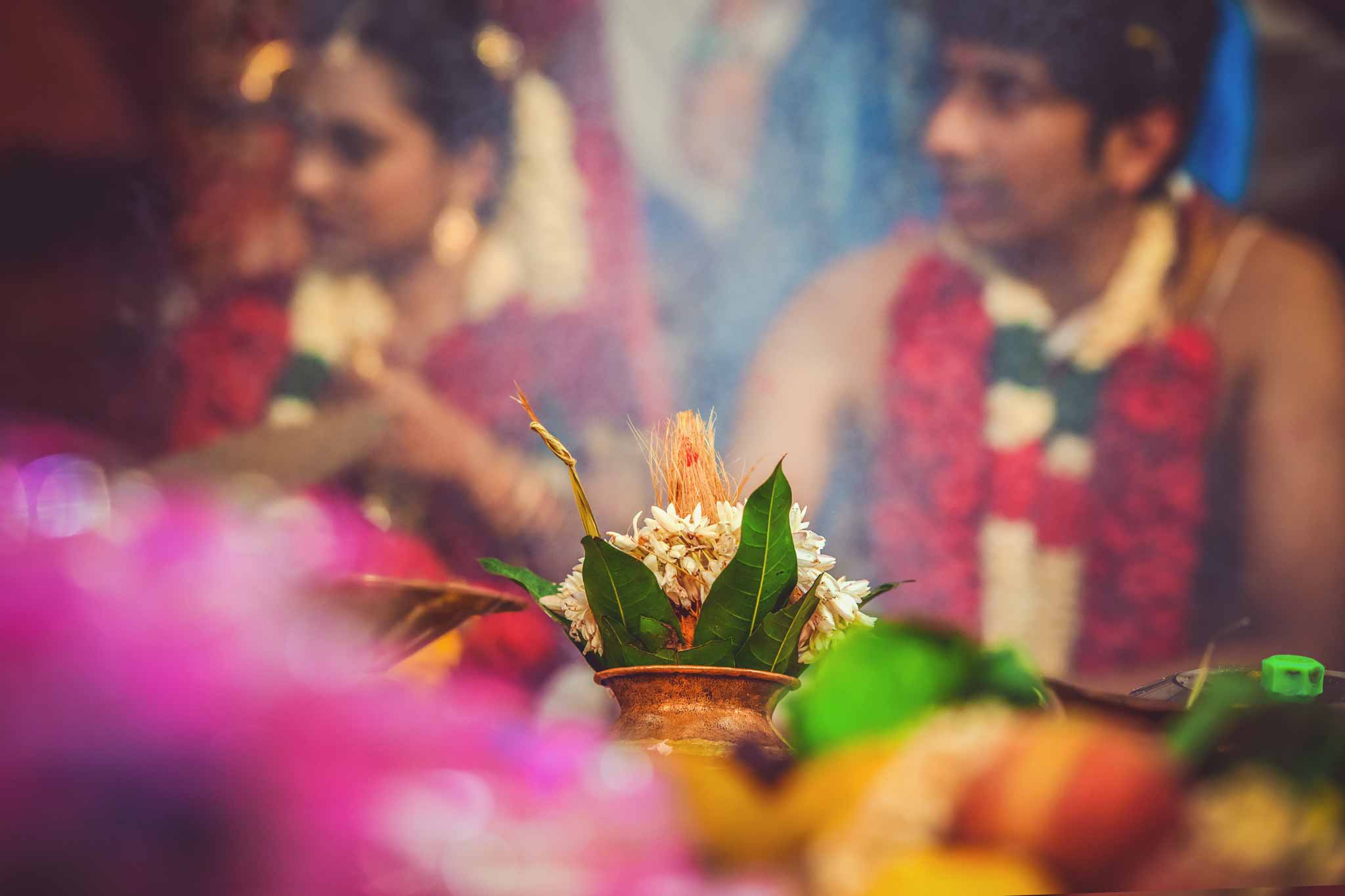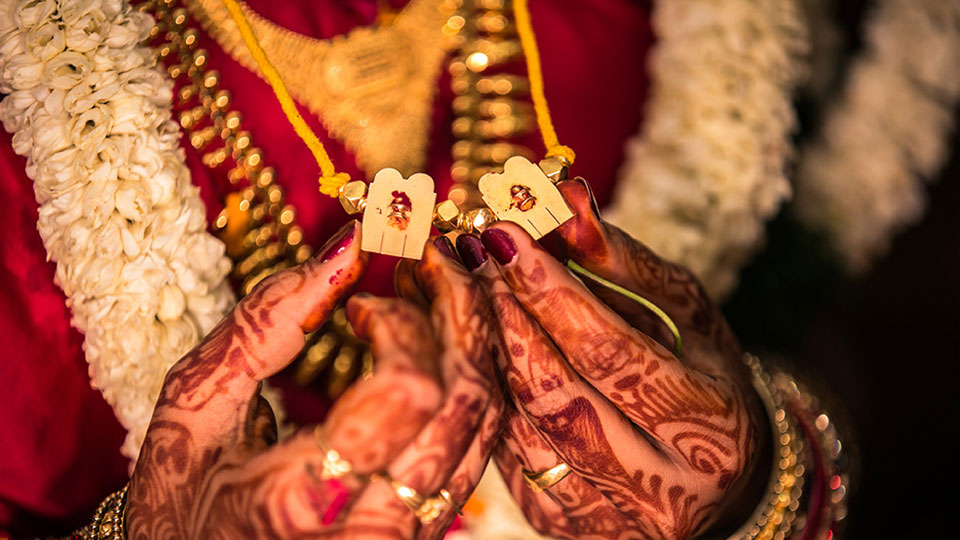A spectacular Tamil wedding is actually a wonderful journey spanning around 2300 years. Even if you are not a Tamilar (a native Tamil), you will love exploring the elaborate and sacred rituals of a Tamil marriage ceremony. Here we present a walk-through the sacred wedding rituals of a Tamil Wedding.
Tamil is one of the oldest cultures, traditions and languages that survived the ravages of time. The Sangam literature is one of the main sources used for documenting the early history of the ancient Tamil country. Secularism is the beauty of this classic literature as it manifests diverse themes prevalent in Tamilakam (the region inhabited by the ancient Tamil people), which covers today’s Tamil Nadu, Kerala, Puducherry, Lakshadweep and Southern parts of Andhra Pradesh and Karnataka, and beyond India’s shores, i.e. Sri Lanka (Sri Lankan Tamils) and the Maldives (Giravarus).

Let’s visit the sacred rituals that make a Tamil wedding ceremony magnificent and fun:
- Panda Kaal Muhurtham
This ceremony marks the beginning of the wedding and is performed individually at the bride’s and the groom’s home to seek the blessings of the family deities for a peaceful, happy, and uninterrupted conduct and completion of the wedding. This ritual is held a day before the actual wedding. However, keeping in mind the modern day busy lives, the function can be held at an earlier date or on the wedding day itself.
A bamboo pole or casuarina pole, after being washed with a mixture of water and milk, is placed beside the door of the house. Families decorate it well with flowers and leaves in a lively environment marked by traditional as well as contemporary songs and dances. A knot is tied to it with a coloured cloth, usually yellow or red colours are considered auspicious.
Married ladies in odd numbers smear sacred turmeric paste on the bamboo while singing songs. The pole is supposed to invoke deities so that the prayer for a successful and peaceful marriage is granted.
Bamboo and casuarina both are evergreen plants. The rationale behind their use in these ceremonies is that parents and families want the bride and groom to enjoy an evergreen relationship.
- Sumangali Prarthanai
Also known as Mangili Pondugal, this ritual, purely a ladies’ function, is celebrated to seek the blessings of sumangalis or pondugal (women of the family who are no more) in the belief that this puja will satisfy the unfulfilled yearnings of women and girls who died young and they would in turn bless the family.
This puja is performed by 5 or 7 married women and 2 Kanya kids (girls who haven’t attained puberty). Married daughters are specially invited as pondugal. Interestingly, the ritual is performed at the groom’s house also either before the wedding day or after the arrival of the bride. However, the intention remains the same.
The Sumangali prarthanai is not performed on Tuesdays and Saturdays. Also the Tamil months of Ādi (mid-July to mid-August) and Mārkazhi (mid-December to mid-January) are not considered auspicious for this ritual. The choice of seasons shows a strong connection between the South Indian and North Indian marriages. Ādi and Mārkazhi stands for Āshāḍha and Mārgaṣīrṣa months of the typical calendars followed in the North India, when marriages are not held.

- Pallikai Thellichal
This ceremony strikes a chord with nature and shows a benevolent side of the Tamil people. In the previous two rituals the importance is on seeking the blessing of deities and deceased family members, but here it is to seek the blessing of fishes and other aquatic animals.
In this ritual, nine varieties of grains along with curd are mixed and filled into seven nicely decorated earthen pots, which are later immersed in water bodies to feed the aquatic creatures. Feeding of fishes is considered very auspicious for the couple and for their future married life.
- Nandi Sharardham
This ritual involves invoking the ancestors to seek their blessings. The ritual is performed independently at the bride’s and the groom’s house a day before wedding. However, in recent times, to cope with the busy life, families consider it apt to perform it in the morning hours of the wedding day and at the wedding venue itself.
Brahmins are invited for the feast. They chant the mantras invoking ancestors and urge them to bless the couple. Families serve them with fruits, supari, coconut, paan, flowers, sweets and veshtiangavastram (traditional clothes). Bride and groom seek blessings of Brahmins for their prosperous married life.
- Mangal Sanaanam
This is the final preparation for the wedding. The ritual is observed separately in the bride’s and groom’s house on the dawn of the wedding day. Women apply Haldi, Kumkum and other fragrant pastes or oil on the bride and groom, before they take the holy bath to get ready for the marriage and perform other wedding rituals.
- GauriPooja
The bride also performs an additional ritual called Gauri Pooja, where she worships Goddess Gauri who is considered a symbol of purity to seek her blessings before going into the nuptial bond. After that she wears the new clothes and accessories presented by the groom’s family.
- Pada Pooja
There are different variations of Pada Pooja across different Tamil communities. In communities like Mudaliar, the bride and groom wash the feet of their parents in their respective homes to seek their blessings before they make their way to the wedding venue.
- Wedding
Eventually comes the wedding ceremony, which is again a multi-ritual process, including Maalai Maatral when the bride and groom exchange flower garlands three times to begin their holy union and Oonjal (also called swing ceremony), where the bride and groom are made to sit on a swing and are offered milk and banana. Rice balls are showered on them as a gesture to ward off evils.
In the Kanyadaanam ritual, the bride’s father gives his daughter in marriage to the groom for eternity. The groom assures the bride’s parents that he will take care of the bride always. Then comes the Muhurtham when the groom applies kumkum/sindoor on the bride’s hair parting and ties a Thaali (mangalsutra) around her neck. Finally, in the Saptapadi, the couple take seven sacred rounds around the fire amidst chanting of mantras.
Hope you loved and enjoyed the adorable journey, the Tamilian style – that unites two souls and families and, even two communities.
Happy matchmaking and happy relationship!






















